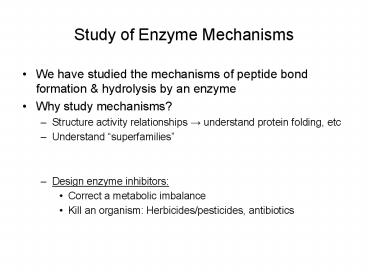Study of Enzyme Mechanisms PowerPoint PPT Presentation
1 / 21
Title: Study of Enzyme Mechanisms
1
Study of Enzyme Mechanisms
- We have studied the mechanisms of peptide bond
formation hydrolysis by an enzyme - Why study mechanisms?
- Structure activity relationships ? understand
protein folding, etc - Understand superfamilies
- Design enzyme inhibitors
- Correct a metabolic imbalance
- Kill an organism Herbicides/pesticides,
antibiotics
2
Diphtheria Toxin
Active peptide
- Corynebacterium diphtheriae
- ADP-ribosyltransferase
- EF NAD ? ADP-EF nicotinamide
- Mechanism also present in other toxins
- Pertussis, E.Coli
- Binding to EF (eukaryotes) blocks translation
3
Reaction
4
Potential Mechanisms?
-OR-
5
Active Site with NAD Bound (1st Step)
Hydrophobic interactions
Nu
6
Testing of Mechanism
- Role of tyrosine?
- Substitute with Phe ? small drop in catalytic
activity - Substitute with Ala ? 105 drop in activity!
- ? likely responsible for substrate recognition
(hydrophobic interactions) - Other mutations show small effects
- Key residues?
- Glu-148 His-21
- Mutations show large drop in catalytic activity
- Glu148Ser 103 drop in activity
7
Plays a role in NAD binding
3-point binding?
Activates incoming nucleophile
8
Role of Glutamic Acid in the TS?
9
2 possible mechanisms?
- In the absence of EF, hydrolysis of NAD will
occur - Model the TS understand how stabilization of TS
occurs - Occurs via an SN2 mechanism!
10
Diphtheria Toxin as a Drug?
- Few successful inhibitors of the diphtheria toxin
have been found - Instead, the toxins apoptotic inducing activity
has been exploited to kill Cancer cells - Active site is maintained
- Alter its targeting ability (to cell receptor)
- Target toxin
- Targeting polypeptide toxic peptide (DT)
Cell receptor
Cell death
11
Determination of Mechanism?
- How do we elucidate a biological pathway or an
enzymes mechanism? - Biological Methods genetic engineering
- Construction of mutants
- Chemical Methods
- Construct analogues (recall the use of fluorine
in tRNA) - Photochemical methods
- Isotopes (stable radioactive)
- OR can use a combination of both methods!
12
Isotopes
- Atoms of the same element having different
numbers of neutrons ? different masses - e.g. 1H, 2H, 3H 12C, 13C, 14C
- Can be used as markers ? exploit a unique
property of isotope detect using analytical
techniques - Radioactivity
- NMR activity
- Different mass (mass spec.)
- Markers can
- Elucidate a biosynthetic pathway
- Provide mechansitic (transition state) information
13
How?
?
feed the labelled compound to the organism
Grow organism
Isolate metabolite look for marker
14
Early Days - Radioisotopes
- Common markers
- 14C (t1/2 5700 y, Nat. Abund. trace)
- 3H (t1/2 12 y, Nat. Abund. 0)
- 32P (t1/2 14 d, Nat. Abund 0)
- Once metabolite is isolated, radioactivity
(decay) is detected - Problems
- Where is the isotope (marker)?
- Harsh degradation methods must be employed ? can
take weeks - Safety
- Availability of precursor
15
For example
- In the 1950s, Birch administered sodium acetate
that was carbon-14 labelled to a Penicillium
organism - Using harsh degradation methods, he was able to
establish how sodium acetate was used to
synthesize 6-MSA
16
Stable Isotopes
- With the development of pulsed NMR came the use
of stable isotopes ? gain information on
connectivity - Mass spectrometry can be used ? little
information location of isotope - Commonly used 2H, 13C, 18O 15N
- Carbon-13
- NMR active (I ½)
- Nat. abundance 1.1
- Many compounds are commercially available
- Used to study the fate of carbon (i.e., C-C bonds
formed bonds broken)
17
- Deuterium
- NMR active (I 1)
- Nat. Abundance 0.015
- Commercially available (i.e. D2O) cheap!
- For the study of the fate or source of hydrogen
- E.g. Which proton is deprotonated? Is a given
proton from H2O or another molecule? - 18O and 15N
- Employed to study the fate of oxygen and nitrogen
- i.e., amino acids Did oxygen come from water or
oxygen?
18
Precursors (what to feed)
- Choice of isotope compound to feed depend on
pathway - i.e.,
- Sodium acetate is an intermediate in many
biochemical pathways - Some knowledge of the pathway helps, but it is
not necessary ? use knowledge of other pathways - Examples
19
Examples
20
- Other possibilities
- Neighboring carbon-13 labels ? 13C-13C (coupled
doublets) - No change in signal intensity ? label did not
incorporate into metabolite! - Deuterium?
- Can use 2H NMR
- Dont need to worry about background deuterium
? any deuterium signal seen, must come from your
precursor
21
A Look Back at 6-MSA
Proposed Pathway

